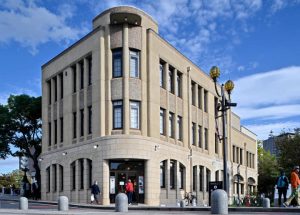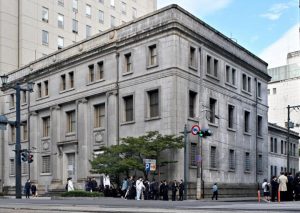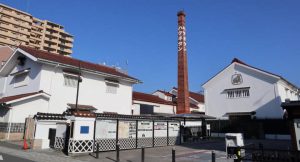Council for Cultural Affairs submits six A-bombed buildings as national historic relics, including Rest House, the former Bank of Japan, Hiroshima Branch, in Hiroshima and Saijo Sake Brewery Group
Oct. 21, 2023
by Masanori Wada and Misato Iwai, Staff Writers
On October 20, the country’s Council for Cultural Affairs submitted a report to the Minister of Education, Culture, Sports, Science and Technology, Masahito Moriyama, to designate nine sites as national historic relics, including the “Hiroshima Atomic Bomb Ruins,” which consists of six atomic-bombed buildings in the city of Hiroshima and the “Saijo Sake Brewery Group” in the city of Higashihiroshima. Nationwide, this is the third time that buildings conveying the horror of the A-bombing will be recognized as national historic relics, and the first time for a sake brewery to be named. A public announcement will be made soon.
All of the A-bombed buildings are within two kilometers of the hypocenter and were evaluated as having left conspicuous traces of the A-bombing. The Rest House in Peace Memorial Park, located in Naka Ward, was built in 1929 as the Taishoya Kimono Shop. It was 170 meters from the hypocenter, and among the city’s 86 remaining A-bombed buildings, was the second closest building after the A-Bomb Dome to remain standing. At the time of the A-bombing, it was being used as an office for the Hiroshima Prefectural Fuel Rationing Union, and 36 people, excluding one in the basement, were killed.
Four other buildings are located in Naka Ward, including the former Bank of Japan, Hiroshima Branch, which is characterized by Greek-style decorative carvings; the walls still have traces of glass shards stuck in them from the A-bombing. Honkawa Elementary School Peace Museum and Fukuromachi Elementary School Peace Museum are former school buildings where many children were killed. The ruins of the Chugoku District Military Headquarters (the former Air Defense Room) are believed to be the place where the first news of Hiroshima’s devastation by the A-bombing was reported.
The belfry of Tamonin Temple in Minami Ward, the closest wooden building to the hypocenter, was spared from collapse by the blast. In the city, the A-bomb Dome was designated a national historic relic in June 1995 and was inscribed as a UNESCO World Heritage site in December 1996.
The Saijo Sake Brewery Group is located in the area of Saijo Sake Brewery Street south of JR Saijo Station and consists of the Enpogura Storehouse of the Hakubotan Sake Brewery, the First Storehouse of the Kamotsuru Sake Brewery, the Daikoku Storehouse of the Fukubijin Sake Brewery, and the former Hiroshima Prefecture Brewing Experiment Station (including the Shusenkan of the Kamoizumi Sake Brewery).
The Enpogura Storehouse is one of the oldest sake storehouses in Japan, believed to have been built in 1675, and the former Hiroshima Prefecture Brewing Experiment Station was built in 1929. The Saijo Sake Brewery Group was recognized for maintaining its landscape with facilities that supported the development of sake brewing from the Edo period (1603-1868) onwards remaining intact.
Other historic relics include the Odaka Castle ruins in the city of Yonago and Jugoroana Tunnel Tombs, one of the largest groups of horizontal tomb sites in Japan, in the city of Hitachinaka, Ibaraki Prefecture. In addition, Sanno Shrine precinct (where there are trees that were exposed to the A-bombing), will be added to the “Nagasaki Atomic Bomb Ruins” historic relics list in the city of Nagasaki. Once designated as an historic relic, government subsidies can be used for repairs, but changes to the existing structure require permission from the Agency for Cultural Affairs.
The report also called for the designation of Sanninu-dai in Yonaguni-cho, Okinawa Prefecture, which is characterized by terraced cliffs and a stepped rocky coast, as both a scenic beauty and protected geologic formation.
(Originally published on October 21, 2023)
On October 20, the country’s Council for Cultural Affairs submitted a report to the Minister of Education, Culture, Sports, Science and Technology, Masahito Moriyama, to designate nine sites as national historic relics, including the “Hiroshima Atomic Bomb Ruins,” which consists of six atomic-bombed buildings in the city of Hiroshima and the “Saijo Sake Brewery Group” in the city of Higashihiroshima. Nationwide, this is the third time that buildings conveying the horror of the A-bombing will be recognized as national historic relics, and the first time for a sake brewery to be named. A public announcement will be made soon.
All of the A-bombed buildings are within two kilometers of the hypocenter and were evaluated as having left conspicuous traces of the A-bombing. The Rest House in Peace Memorial Park, located in Naka Ward, was built in 1929 as the Taishoya Kimono Shop. It was 170 meters from the hypocenter, and among the city’s 86 remaining A-bombed buildings, was the second closest building after the A-Bomb Dome to remain standing. At the time of the A-bombing, it was being used as an office for the Hiroshima Prefectural Fuel Rationing Union, and 36 people, excluding one in the basement, were killed.
Four other buildings are located in Naka Ward, including the former Bank of Japan, Hiroshima Branch, which is characterized by Greek-style decorative carvings; the walls still have traces of glass shards stuck in them from the A-bombing. Honkawa Elementary School Peace Museum and Fukuromachi Elementary School Peace Museum are former school buildings where many children were killed. The ruins of the Chugoku District Military Headquarters (the former Air Defense Room) are believed to be the place where the first news of Hiroshima’s devastation by the A-bombing was reported.
The belfry of Tamonin Temple in Minami Ward, the closest wooden building to the hypocenter, was spared from collapse by the blast. In the city, the A-bomb Dome was designated a national historic relic in June 1995 and was inscribed as a UNESCO World Heritage site in December 1996.
The Saijo Sake Brewery Group is located in the area of Saijo Sake Brewery Street south of JR Saijo Station and consists of the Enpogura Storehouse of the Hakubotan Sake Brewery, the First Storehouse of the Kamotsuru Sake Brewery, the Daikoku Storehouse of the Fukubijin Sake Brewery, and the former Hiroshima Prefecture Brewing Experiment Station (including the Shusenkan of the Kamoizumi Sake Brewery).
The Enpogura Storehouse is one of the oldest sake storehouses in Japan, believed to have been built in 1675, and the former Hiroshima Prefecture Brewing Experiment Station was built in 1929. The Saijo Sake Brewery Group was recognized for maintaining its landscape with facilities that supported the development of sake brewing from the Edo period (1603-1868) onwards remaining intact.
Other historic relics include the Odaka Castle ruins in the city of Yonago and Jugoroana Tunnel Tombs, one of the largest groups of horizontal tomb sites in Japan, in the city of Hitachinaka, Ibaraki Prefecture. In addition, Sanno Shrine precinct (where there are trees that were exposed to the A-bombing), will be added to the “Nagasaki Atomic Bomb Ruins” historic relics list in the city of Nagasaki. Once designated as an historic relic, government subsidies can be used for repairs, but changes to the existing structure require permission from the Agency for Cultural Affairs.
The report also called for the designation of Sanninu-dai in Yonaguni-cho, Okinawa Prefecture, which is characterized by terraced cliffs and a stepped rocky coast, as both a scenic beauty and protected geologic formation.
(Originally published on October 21, 2023)










